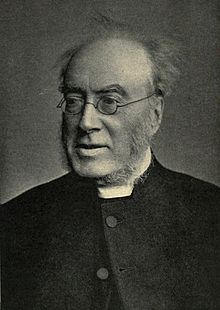George Salmon
| George Salmon | |
|---|---|
 |
|
| Born |
25 September 1819 Dublin |
| Died | 22 January 1904 (aged 84) Trinity college |
| Spouse(s) | Frances Anne Salvador |
| Parent(s) | Michael Salmon, Helena Weekes |
| Awards |
Royal Medal (1868) Copley Medal (1889) |
George Salmon (25 September 1819 – 22 January 1904) was an Irish mathematician and Anglican theologian. After working in algebraic geometry, Salmon devoted the last forty years of his life to theology. His entire career was spent at Trinity College Dublin.
Salmon was almost certainly born in Dublin, to Michael Salmon and Helen Weekes (the daughter of the Reverend Edward Weekes), but he spent his boyhood in Cork City, Ireland, where his father Michael was a linen merchant, here he attended Hamblin and Porter's School before going to Trinity College in 1833. He graduated from Trinity College Dublin in 1839 with very high honors in mathematics. In 1841 at the age of 21 he attained a paid fellowship and teaching position in mathematics at Trinity. In 1845 he was concurrently appointed to a position in theology at Trinity, after having been ordained a deacon in 1844 and a priest in the Church of Ireland in 1845.
He remained at Trinity College Dublin for the rest of his career. He married in 1844 Frances Anne, daughter of Rev J L Salvador of Staunton, Herefordshire with whom he had six children, of whom only two survived him. He died at Trinity college and was buried in Mount Jerome cemetery, Dublin.
In the late 1840s and the 1850s Salmon was in regular and frequent communication with Arthur Cayley and J.J. Sylvester. The three of them together with a small number of other mathematicians (including Charles Hermite) were developing a system for dealing with n-dimensional algebra and geometry. During this period Salmon published about 36 papers in journals. In these papers for the most part he solved narrowly defined, concrete problems in algebraic geometry, as opposed to more broadly systematic or foundational questions. But he was an early adopter of the foundational innovations of Cayley and the others. In 1859 he published the book Lessons Introductory to the Modern Higher Algebra (where the word "higher" means n-dimensional). This was for a while simultaneously the state-of-the-art and the standard presentation of the subject, and went through updated and expanded editions in 1866, 1876 and 1885, and was translated into German and French.
...
Wikipedia
